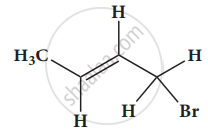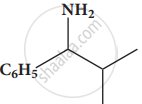Advertisements
Advertisements
प्रश्न
Give the IUPAC names of the following compound.

उत्तर
2 – ethoxypropane
APPEARS IN
संबंधित प्रश्न
Observe the following structures and answer the questions given below.
- \[\ce{CH3 - CH2 - CH2 - CHO}\]
\[\begin{array}{cc}\ce{CH3 - CH - CHO}\\
|\phantom{...}\\\ce{CH3}\end{array}\]
a. What is the relation between (i) and (ii)?
b. Write IUPAC name of (ii).
c. Draw the functional group isomer of (i).
Phytane is a naturally occurring alkane produced by the alga spirogyra and is a constituent of petroleum. The IUPAC name for phytane is 2,6,10,14-tetramethylhexadecane. Write a zig-zag formula for phytane. How many primary, secondary, tertiary, and quaternary carbons are present in this molecule?
Observe the following and answer the questions given below:
\[\ce{CH3 - CH3 ->[U.V. light] \overset{\bullet}{C}H3 + \overset{\bullet}{C}H3}\]
- Name the reactive intermediate produced.
- Indicate the movement of electrons by a suitable arrow to produce this intermediate.
- Comment on the stability of this intermediate produced.
An electronic displacement in a covalent bond is represented by the following notation.

A. Identify the effect
B. Is the displacement of electrons in a covalent bond temporary or permanent.
| A covalent bond in tert-butyl bromide breaks in a suitable polar solvent to give ions. |
- Name the anion produced by this breaking of a covalent bond.
- Indicate the type of bond breaking in this case.
- Comment on the geometry of the cation formed by such bond cleavage.
Give the IUPAC names of the following compound.

Give the IUPAC names of the following compound.

Give the IUPAC names of the following compound.

Hybridisation of C-atom to which -OH group is attached in the below given compound is:

Consider the following reactions.
\[\ce{C6H5N^+_2Cl- ->[HBF4] A ->[NaNO2/Cu] B ->[Sn/HCl] C}\]
Identify the compound formed C in the above reaction.
